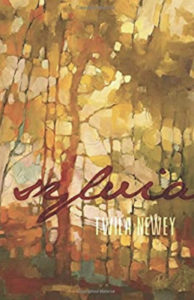Review
Title: Sylvia
Author: Twila Newey
Publisher: BCC Press
Genre: Fiction
Year Published: 2020
Copyright: 2020
Number of Pages: 280
Binding: Soft Cover
ISBN13: 978-1-948218-34-4
Price: 12.95
Reviewed by Denice Mouncé for the Association for Mormon Letters
Sylvia is a fictional account of four sisters struggling with the sudden and unexpected loss of their mother whose name is reflected in the title of the book. The story travels between their modern lives as adults and their childhood memories as it weaves a path to reveal how the sisters developed into the women that they became. The imagery is exceptional while the characters, plot, and religious allusions are problematic.
From the beginning, the author’s words paint vibrant and beautiful pictures of the scenes that make it easy for the reader to fall into the story. These scenes have the sepia tone of childhood memories and summers long gone. These endearing descriptions and visuals continue throughout the story and take the reader on a visual journey.
Throughout the book, there are allusions to Biblical references of the creation. They begin with the benign: “And there was evening and there was morning, the first day.” (p.5) Which continues to count through the days from their mother’s death until the funeral a week later. The book concludes with the following exact quote (sic – including block brackets), “[S]he blessed the seventh day and hallowed it, because on it she rested from all the work of [her] creation.” The author may have been expressing that the spirit of Sylvia healed her daughters in the week after her death and brought them closer together, but by choosing to do it as a rewording of clear allusions to scripture with a feminine pronoun it felt like a statement of something more.
The awkward religious connections continued when each of the main characters has a special story that their mother tells them every night. In this story, their names are presented with a reinterpretation of their religious namesake’s story to include their personality types. It is uncomfortable and disjointed.
The characters of the story are archetypes to the point of cliché. We have Eve, who struggles with her husband through infertility. Roxcy, the wealthy wife obsessed with perfection and endlessly busy with her lists. Mary, the working widow with a son in the military. And the spoiled and emotionally immature youngest, Anna, who has left the church with her daughters after her husband betrayed her. Anna is painted as a Jezebel-type as she dons a low-cut sensual dress at her mother’s funeral. The archetypes were so strong that they were difficult to connect with.
The characters were one dimensional and did not experience growth in the story. The book did spend time trying to explain how they became the way they are but did not focus on any further development. The theme of the book seems to be that individuals are exactly as they should be when you understand how they came to be that way and do not need to change, but those in their lives need to adapt to meet their needs.
The story seemed to center on the holes in their lives created by the absence of their mother. Instead of taking personal accountability and growing, the author concluded the story with the sisters taking on their mother’s role in each other’s lives. In some ways, this seemed sweet, but in others, it was concerning. The story carried a tone of the sister’s choosing to rely on others for their needs instead of learning to do things for themselves.
A couple of glaring examples of this were early in the story where two sisters had different questions that could easily have been checked through various sources, but instead, they decided to wait until their husbands were there so that their husbands could tell them what the stance of the church was on these things. Overall, the characters of the story felt powerless and dependent.
The characters, religious themes, and lack of growth made the story uncomfortable and unfulfilling. Twila Newey has a talent for words and the imagery she conjures paints vibrant portraits of the people and places she describes. Poetry and prose are truly talents of hers and their inclusion in this story makes the imagery come alive to the reader.

